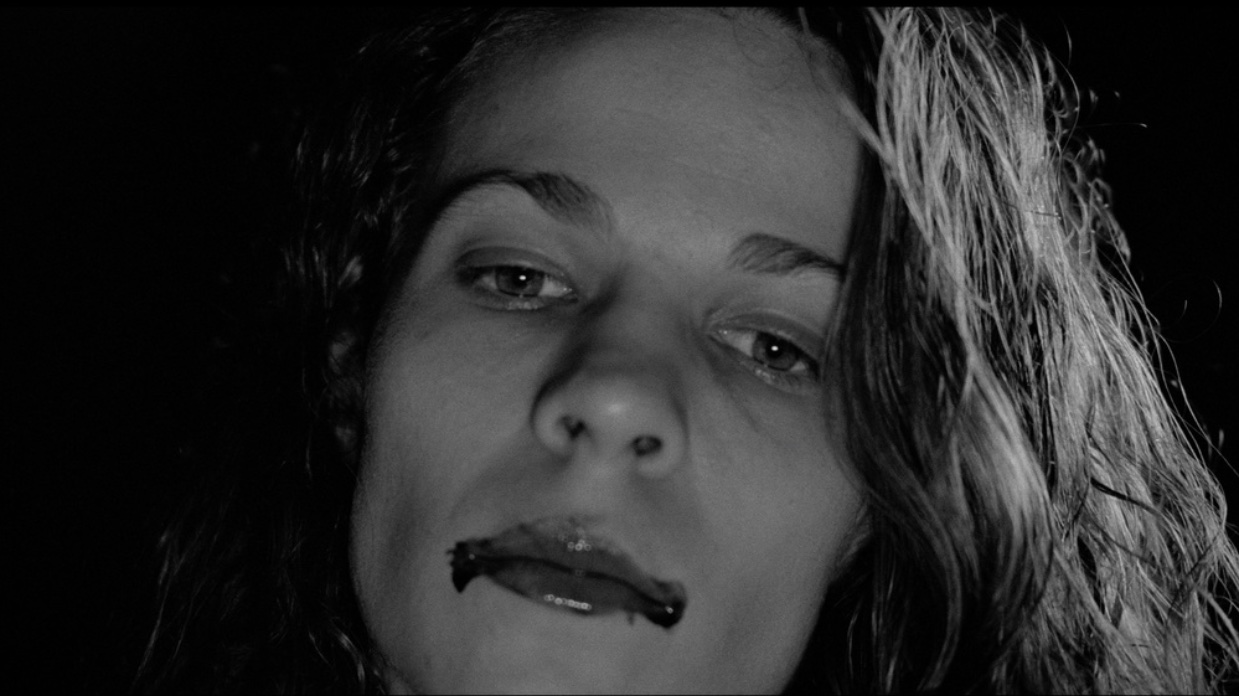 Back to selection
Back to selection
Bloody Thoughts: Abel Ferrara on The Addiction
 The Addiction
The Addiction Appearing online for the first time, here is Scott Macaulay’s report on Abel Ferrara’s The Addiction, from our Winter, 1995 edition. It appears here in newly revised form.
“Look at this,” Abel Ferrara says, tracing his finger across the video monitor in his Manhattan office/editing room. On the screen: black-and-white images of blood-streaked, bullet-ridden Bosnian casualties. “This is the real thing.”
These images, and others of Nazi concentration camp victims from Ferrara’s new film The Addiction, pose a cinematic question that dates back at least to Alain Resnais’ Night and Fog. When faced with the visual representation of the extreme horrors of the 20th century, what does a filmmaker do with these images?
Well, if you’re Ferrara, you put them in a horror film. The Addiction, directed by Ferrara and scripted by Nicolas St. John, is Ferrara’s return to low-budget viscerality of his early works—Driller Killer and Ms. 45—while it also more explicitly extends the kind of searching moral dialogues that are at the heart of his more recent films. As in Bad Lieutenant, in which a corrupt Catholic cop’s last days played out like a medieval morality play, in this film too a genre’s subtexts are laid bare. Lily Taylor plays an NYU philosophy grad student-turned-bloodsucker enrolled in a Holocaust studies class, and much of the film’s dialogue, quoting Heidegger, Husserl, Burroughs, and Sartre, provides an overt philosophical rationale for the themes long associated with the the vampire movie: questions of identity, one’s role in society, and one’s exploration of individual morality.
Indeed, thoughts flow from St. John’s script like karo syrup in a grindhouse gorefest. With Ken Kelsch’s evocative, chiaroscuro cinematography, sudden eruptions of violence, and possessed performances by Lily Taylor and Christopher Walken, the film blends the grittiness of Night of the Living Dead with the poetic horror of such directors as Georges Franju and Jacques Tourneur.
“They’re not making horror movies like they used to,” Ferrara says, when I comment that horror has ceased to become a vehicle for serious social ideas. “I don’t know why.”
It’s a month before Sundance, 1995, it’s dark outside, and I’m talking with Ferrara in that 18th St. office, near Union Square, while editor Anthony Redmond works in the other room. I’ve been trying to get in touch with the director in order to see the movie and write this piece, slated for the Sundance section of our print issue, which will go to the printer in the next few days. The publicist has been blowing me off until just earlier tonight. “Abel wants you to come by around 11:00 PM,” she says on the phone. So, here I am.
“You’re a fan, right?” Ferrara asks me. “Yeah,” I confess. “You should see it on the big screen, so just watch enough of it to get a taste,” he says, before leaving me in a room with a VHS player and a stack of tapes, broken into reels. I watch the first two — about 40 minutes — and head out, and we talk some more.
In The Addiction, Lily Taylor retches, uses hypodermic needles to steal blood from her victims, and shoots up over her toilet. The parallels to heroin addiction are obvious but Ferrara tells me that the vampire/addiction metaphor is a broader one: “We are what we are addicted to,” he remarks. “Business, money, alcohol…”
The Addiction got made when Ferrara realized that the “real thing”—its ideas, not its vampire storyline—were what was preventing the film from getting funded. “We sent it out to the usual people but they didn’t get it. How can you explain this movie? Like Bad Lieutenant. How could you explain what that movie was going to be? I didn’t know and I’m the director, writer. So I got [the cast and crew] together and said, ‘Let’s make a movie that we own, something totally radical. We’ll make it and then show it around.’ It’s a great feeling. We own the movie.”
Ferrara conceived The Addiction as a low-budget, black-and-white film to be shot over 20 days. “Twenty days, that’s a good schedule for us. Cut the bullshit. We know what we want to do and do it, not sit around jerking off. That’s what we shot Bad Lieutenant in.”
If Ferrara’s style of production seems to prioritize action over thought, then it might seem odd that this latest project is so heady—the film even boats soundtrack music by Frederick Nietzsche. But the confluence of philosophy and vampirism is not so unlikely as it may seem because philosophy itself is inherently vampiristic. Feeding off the past, continually regenerating old ideas, it saps our will to action by redirecting it towards abstraction and theorization. The movie’s use of Bosnian and Holocaust imagery may be startling if only for the manner in which Taylor’s study of these images sets up her somewhat complicitous slip into vampirism. With so many bloodbaths all around her, it’s hard to tell where one begins and another ends.
Ferrara interrupts the interview: “Didja see the Walken scene? You gotta see Walken.” Now past midnight, he turns back on the video and shows me more of the film.
As the music editor cuts Joe Delia’s score in the other room, trying to sync the cues to the exact moments Taylor bites into her victims, I see more bits and pieces of the movie. With this one almost done and slotted for a premiere at Sundance, Ferrara is back on the phone, rehearsing tomorrow’s pitch to do another movie: “We’ve only got one chance. We’ve gotta go in and just do it.”
